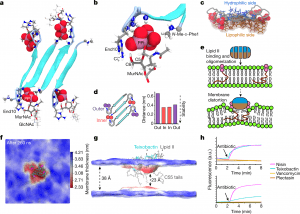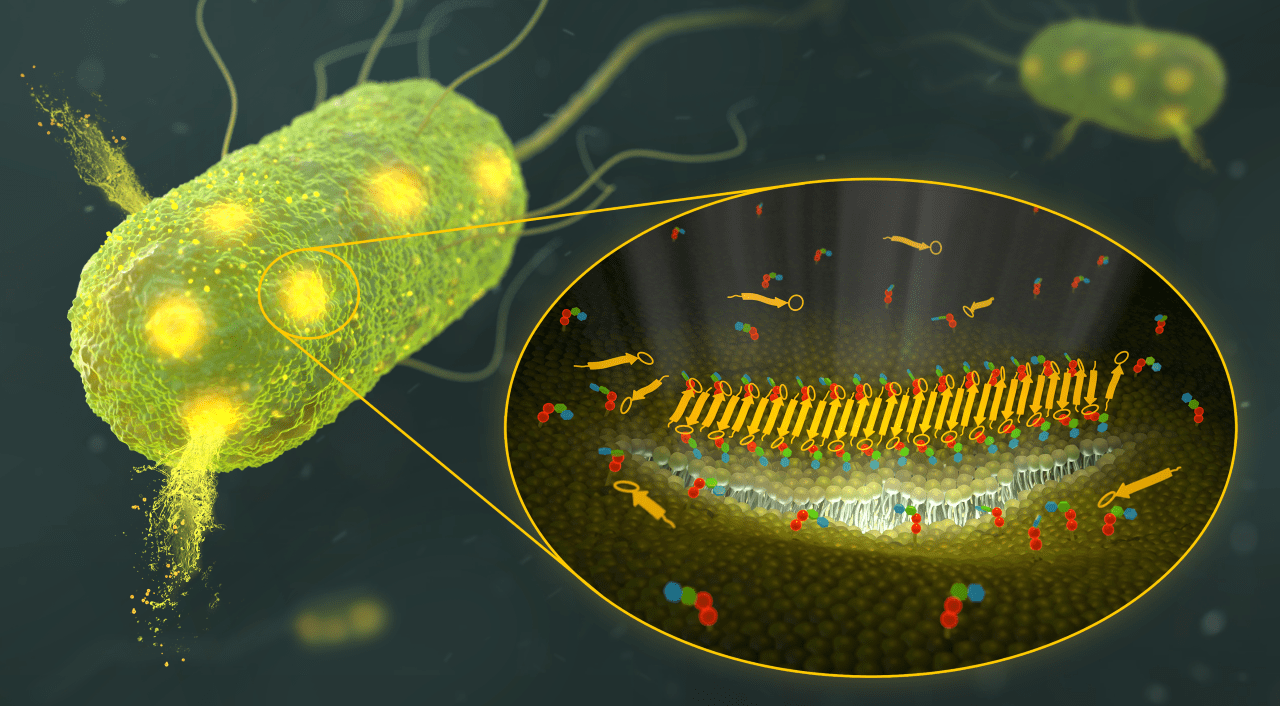The University of Utrecht scientists have uncovered a novel mechanism for how drugs eradicate antibiotic-resistant bacteria. Teixobactin, an antibiotic, kills bacteria by destroying their cell membrane and preventing the formation of their cell walls, according to research published in the peer-reviewed journal Nature. The new understandings might make it possible to create potent antibiotics that bacteria are less likely to acquire resistance to.

Image Source: https://doi.org/10.1038/s41586-022-05019-y
One of the most often prescribed medications in the world, antibiotics are used to treat bacterial infections. They are essential in the fight against numerous diseases of the digestive and respiratory systems, as well as a number of skin problems. However, because the majority of antibiotic classes currently used in clinics have been around for roughly 50 years, bacteria have grown more resistant to antibiotics. The first novel antibiotic identified in about 40 years, teixobactin, was successfully isolated in 2015 by researchers from Boston, USA.
Antibiotics having innovative mechanisms are required to tackle antimicrobial resistance. Teixobactin is a new family of antibiotics lacking demonstrable resistance and a distinctive chemical structure. Teixobactin ingeniously solves the toxicity issue by only damaging membranes containing lipid II, lacking in eukaryotes.
Teixobactin was produced by so-called “unculturable” bacteria, which do not flourish in standard laboratory settings, and it showed exceptional potency against bacterial infections without exhibiting any signs of resistance. Teixobactin’s mode of action in killing bacteria has not yet been determined. The ribosome is where most antibiotics bind. These antibiotics accomplish this by preventing the bacteria’s ability to produce proteins. Antibiotics can also prevent bacteria from producing peptidoglycan, which serves as their outermost layer of defense. It quickly became apparent that teixobactin also accomplishes this, though not in the same manner.
Unique killing mechanism

Image Source: https://doi.org/10.1038/s41586-022-05019-y
Seven years after its discovery, a large multinational team under the leadership of Associate Professor Markus Weingarth from the University of Utrecht has now uncovered the chemical mechanism by which teixobactin destroys bacteria. The group worked with the creators of teixobactin, Prof. Kim Lewis of Northeastern University in Boston and the company Novobiotic, and employed a number of cutting-edge structural biology approaches.
Bacteria require a unique lipid called lipid II to create their protective envelope. The scientists demonstrate that teixobactin binds and sequesters lipid II at the atomic level. Then, on the membranes of bacteria, teixobactin and lipid II combine to produce lengthy fibrils. Gradually, this forms a valley in the cell membrane’s topography, which eventually degrades and harms the membrane. It turned out that the Utrecht scientists had discovered a biomolecular mechanism that had previously eluded science. It is a unique mechanism of killing.
Designing more potent drugs against certain respiratory diseases
The complex produced by teixobactin and lipid II at the atomic level in lipid membranes was solved by Weingarth and Ph.D. candidate Rhythm Shukla using a solid-state nuclear magnetic resonance (ssNMR) method. The scientists then used a variety of microscopy techniques to visualize the fibrils directly in bacteria and in membranes.
This effective technique is being used for the first time in this study to describe how membrane-active antibiotics function. It can be difficult to comprehend drugs that impact the cell membrane. Now, as the study reveals the mechanism of action of teixobactin, it will be sensible to develop more potent drugs against pneumonia, tuberculosis, or infections with MRSA bacteria. Resistance to the current antibiotics is a major issue for all of these respiratory disorders.
Story Source: Shukla, R., Lavore, F., Maity, S. et al. Teixobactin kills bacteria by a two-pronged attack on the cell envelope. Nature (2022). https://doi.org/10.1038/s41586-022-05019-y
https://www.uu.nl/en/news/youngest-antibiotic-kills-bacteria-via-a-new-two-step-mechanism
Learn More:
Top Bioinformatics Books ↗
Learn more to get deeper insights into the field of bioinformatics.
Top Free Online Bioinformatics Courses ↗
Freely available courses to learn each and every aspect of bioinformatics.
Latest Bioinformatics Breakthroughs ↗
Stay updated with the latest discoveries in the field of bioinformatics.
Dr. Tamanna Anwar is a Scientist and Co-founder of the Centre of Bioinformatics Research and Technology (CBIRT). She is a passionate bioinformatics scientist and a visionary entrepreneur. Dr. Tamanna has worked as a Young Scientist at Jawaharlal Nehru University, New Delhi. She has also worked as a Postdoctoral Fellow at the University of Saskatchewan, Canada. She has several scientific research publications in high-impact research journals. Her latest endeavor is the development of a platform that acts as a one-stop solution for all bioinformatics related information as well as developing a bioinformatics news portal to report cutting-edge bioinformatics breakthroughs.












